|
Advertisement / Annons: |
Comet
|
| Object : | Comet, C/2022 E3 ZTF |
| Coordinates/Direction : | - |
| Object size : | - |
| Object magnitude : | 5.1 at max |
| More to know : |
You can read more about the comet on Seiichi Yoshida's homepage: http://www.aerith.net/ comet/ catalog/ 2022E3/ 2022E3.html |
|
Star chart from 31 January 2023 and the following days, the view is North and from Stockholm, Sweden. You can download CdC and make your own star chart for your place here: CdC: 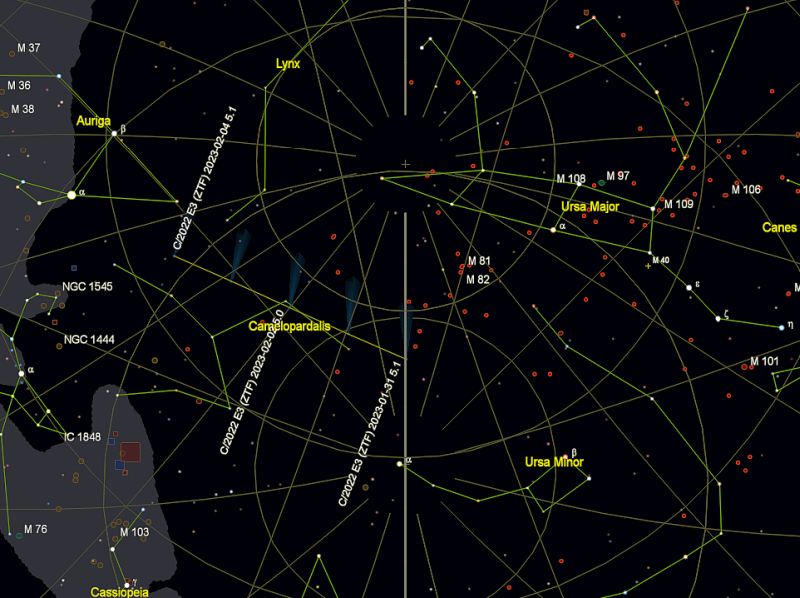
Star chart in high resolution: B/W or Color, opens in a new window. |
|
|
Comet's light curve:  Credit: software 'Comet for Windows' from Seiichi Yoshida
Credit: software 'Comet for Windows' from Seiichi Yoshida
The magnitude of the comet around the days I photographed it. |
2023-02-05, Comet ZTF
|
| Date : | 2023-02-05 |
| Time (UT) : | 17:23 to 18:42 |
| Mount : | SkyWatcher HEQ5, belt modified, low rider |
| Guide : | QHY5 camera with 200 mm f/3.5 lens |
| Lens/telescope : | Pentax 645 300 mm ED f/4 (medium format lens) |
| Corrector/Barlow : | - |
| Field (FOV) : | 6.8x4.5o (full frame) before crop |
| camera : | Canon 6D, QE=0.5, full frame, 20 Mpixel, 14 bit |
| camera temperature: | About 6o C above surrounding temperature |
| Film/CCD : | Raw, Cr2 |
| Filter : | none |
| Control system: | Mount, camera, focus, guide (Ekos) controlled by Astroberry (KStars/Ekos Linux) |
| Exp. time : | 15x60 second at iso1600 |
| Image process tool : | Siril, Gimp, Irfanview |
| Processing : | cal dark, align on comet core |
| Weather : | Clear Sky, -3 degrees Celsius, full Moon |
| Site : | Sweden, Stockholm, Tyresta Nature reservation, Spirudden. Bortle 4 |
| Comment : | One more clear night and this time I joined company with my friend. After we had setup the equipment we had less than two hours before the clouds rolling in. I could only use 15 of the photos I took this night with a very noisy image. It wasn't only the clouds, it was full Moon this night which cause even more noise. But this was one of the last nights with the comet when it's relative bright, about magnitude 5.3. The positive thing that it was almost up in the zenith, Dec +76 degrees. |
2023-02-02, Comet ZTF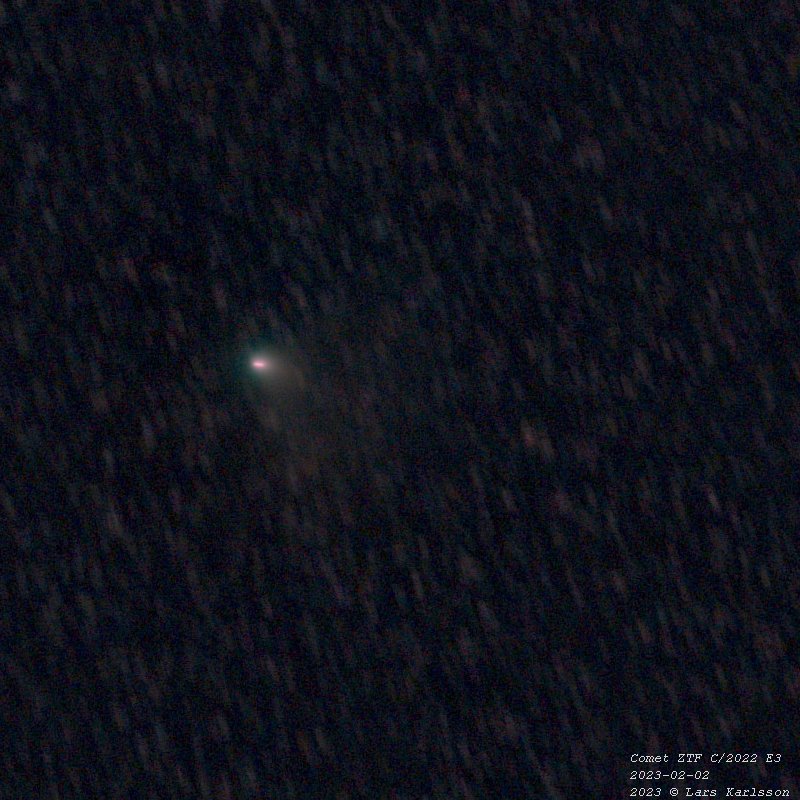
|
| Date : | 2023-02-02 |
| Time (UT) : | 17:31 to 19:52 |
| Mount : | Tripod |
| Lens/telescope : | Canon 50mm f/1.8 |
| Corrector/Barlow : | - |
| Field (FOV) : | 39.4x26.8o (full frame) before crop |
| camera : | Canon 6D, QE=0.5, full frame, 20 Mpixel, 14 bit |
| camera temperature: | About 6o C above surrounding temperature |
| Film/CCD : | Raw, Cr2 |
| Filter : | none |
| Control system : | Camera focus by Canon Remote APP, camera exposure by intervallometer |
| Exp. time : | 259x30 second at iso1600, of all these only 72 photos was used, at f/4 |
| Image process tool : | Siril, Gimp, Irfanview |
| Processing : | cal dark, align on comet core |
| Weather : | Clear Sky, -8 degrees Celsius |
| Site : | Sweden, Stockholm, Tyresta Nature reservation, Spirudden. Bortle 4 |
| Comment : | This night I did a little experiment, I only used a tripod instead of my GoTo equipment. With that I can only take short exposures and use a short focal length. The main goal was to take so many photos that I can do a time lapse video of the comet. But first is the stacked image of 71 sub photos of it. This is something you can do with most DSLR or mirror less cameras. The lens I used is a standard normal lens, a 50 mm f/1.8 Canon lens, very cheap as used. A sturdy tripod is also good to have but what ever that hold your camera stable can be used. The 30 seconds exposures I did was a bit long, better with 15 seconds. The camera battery was drained after 300 photos and the battery for the heater band was drained already after one hour, but no fog on the lens so it didn't matter this evening. |
2023-01-27, Comet ZTF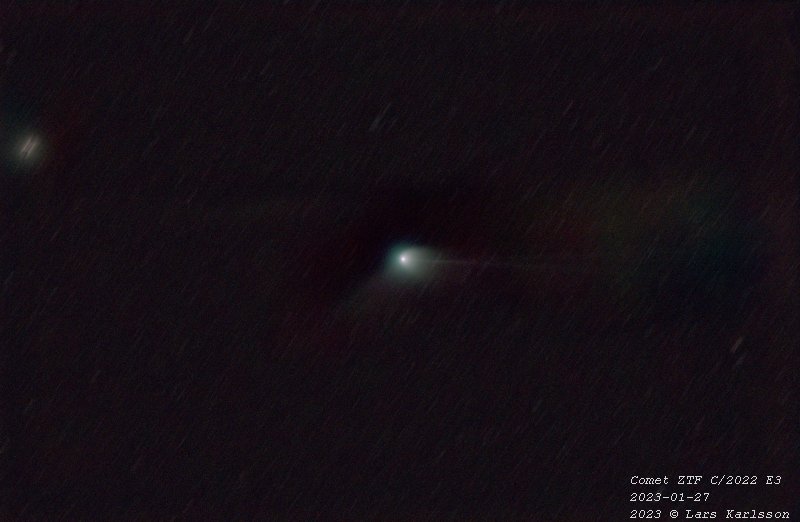
|
| Date : | 2023-01-27 |
| Time (UT) : | 21:04 to 21:45 |
| Mount : | SkyWatcher HEQ5, belt modified, low rider |
| Guide : | QHY5 camera with 200 mm f/3.5 lens |
| Lens/telescope : | Pentax 645 300 mm ED f/4 (medium format lens) |
| Corrector/Barlow : | - |
| Field (FOV) : | 6.8x4.5o (full frame) before crop |
| camera : | Canon 6D, QE=0.5, full frame, 20 Mpixel, 14 bit |
| camera temperature: | About 6o C above surrounding temperature |
| Film/CCD : | Raw, Cr2 |
| Filter : | none |
| Control system: | Mount, camera, focus, guide (Ekos) controlled by Astroberry (KStars/Ekos Linux) |
| Exp. time : | 30x60 second at iso1600 |
| Image process tool : | Siril, Gimp, Irfanview |
| Processing : | cal dark, flat align on comet core |
| Weather : | Clouds comes and go |
| Site : | Sweden, Stockholm, Björnö Nature reservation. Bortle 4 |
| Comment : |
Back to the balcony, disappointed of the last nights trouble I need to practice at home.
The problem is that it's so difficult to control the equipment from the Android tablet.
After one more night and only using the tablet I think I now master this.
The main fail was that I started the repeat function when doing polar align to early.
Now I also learned how to use the smartphone to control the equipment, easier than I thought. The photo ? Not very good weather this night, but good enough to do this important test. |
2023-01-26, Comet ZTF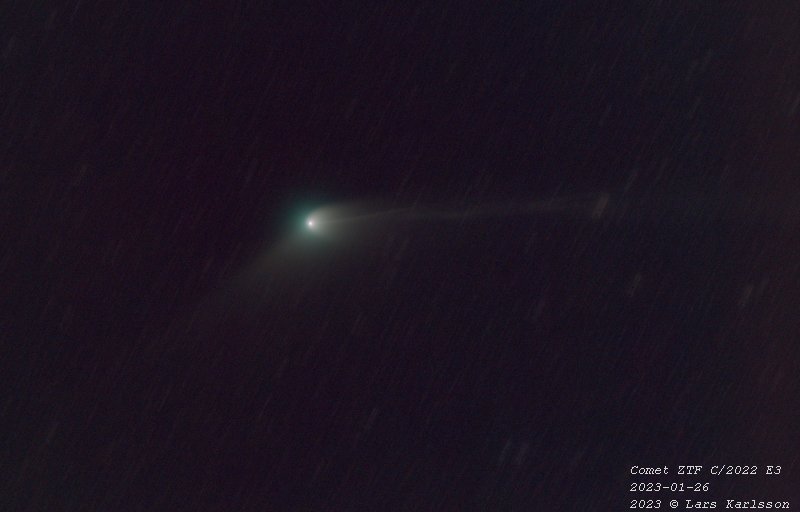
|
| Date : | 2023-01-26 |
| Time (UT) : | 22:39 to 23:41 |
| Mount : | SkyWatcher HEQ5, belt modified, low rider |
| Guide : | QHY5 camera with 200 mm f/3.5 lens |
| Lens/telescope : | Pentax 645 300 mm ED f/4 (medium format lens) |
| Corrector/Barlow : | - |
| Field (FOV) : | 6.8x4.5o (full frame) before crop |
| camera : | Canon 6D, QE=0.5, full frame, 20 Mpixel, 14 bit |
| camera temperature: | About 6o C above surrounding temperature |
| Film/CCD : | Raw, Cr2 |
| Filter : | none |
| Control system: | Mount, camera, focus, guide (Ekos) controlled by Astroberry (KStars/Ekos Linux) |
| Exp. time : | 53x30 second at iso1600 |
| Image process tool : | Siril, Gimp, Irfanview |
| Processing : | cal dark, flat align on comet core |
| Weather : | Clear sky with a 1/4 Moon |
| Site : | Sweden, Stockholm, Björnö Nature reservation. Bortle 4 |
| Comment : | Just one week left to its closest approach to us. We took the car out to a dark area to get better photographs. But get in a lot of trouble when I try to polar align the mount. At home at the balcony it works perfect and is easy to do. I struggled with it for 2 hours and then gave up. Align it as good I could by eye to Polaris and start Photographing. The photo is a bit crop and is almost 5 degrees wide. The tails is now very visible and goes far away from the comet's core, more than 3 degrees. The magnitude of the comet is about 5.6 this night. |
2023-01-26, Comet ZTF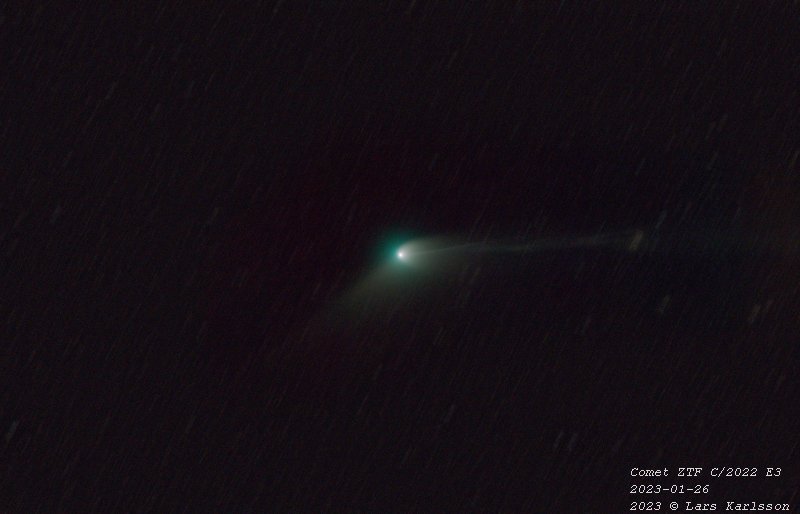
|
| Date : | 2023-01-26 |
| Time (UT) : | 21:30 to 22:19 |
| Mount : | SkyWatcher HEQ5, belt modified, low rider |
| Guide : | QHY5 camera with 200 mm f/3.5 lens |
| Lens/telescope : | Pentax 645 300 mm ED f/4 (medium format lens) |
| Corrector/Barlow : | - |
| Field (FOV) : | 6.8x4.5o (full frame) before crop |
| camera : | Canon 6D, QE=0.5, full frame, 20 Mpixel, 14 bit |
| camera temperature: | About 6o C above surrounding temperature |
| Film/CCD : | Raw, Cr2 |
| Filter : | none |
| Control system: | Mount, camera, focus, guide (Ekos) controlled by Astroberry (KStars/Ekos Linux) |
| Exp. time : | 30x60 second at iso1600 |
| Image process tool : | Siril, Gimp, Irfanview |
| Processing : | cal dark, flat align on comet core |
| Weather : | Clear sky with a 1/4 Moon |
| Site : | Sweden, Stockholm, Björnö Nature reservation. Bortle 4 |
| Comment : | The other set I took this night was with twice as long exposures on each, but the total exposure is the same because I only took 30 of them. This make it easier to lift the tail above the noise from the light pollution. |
2023-01-26, Comet ZTF core
|
| Date : | 2023-01-26 |
| Time (UT) : | 21:30 to 22:19 |
| Comment : | A zoom in at the core show how the dust part of it surrounding the inner core. The core itself is only 1 km, much smaller than a pixel on this photo, it's the dust we see. The color comes when the Sun's photons absorbs by the comets molecules and then emit it in the green wave length. Most from carbon and cyanogen. |
2023-01-26, Comet ZTF tail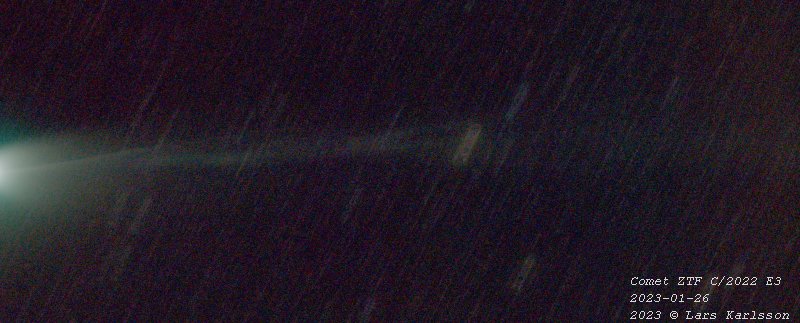
|
| Date : | 2023-01-26 |
| Time (UT) : | 21:30 to 22:19 |
| Comment : | A zoom in on the comet's tail. The tail is much weaker and is more difficult to see. With longer exposures the tail will be better but the comet moves fast relative the stars when it's close to our Earth. The mount follow the stars, not the comet. But it's possible to reprogram the motors to follow the comet's speed. I should have done that but something wrong in the software. The limit was 60 seconds exposure time, more and the comet had been blurred because of the speed. It can be seen that the tails have some interruptions, I'm not sure why but I think it comes when the comet rotates and turn different sides to the Sun. |
2023-01-20, Comet ZTF (Click on the image and get one in full resolution in a new window)
(Click on the image and get one in full resolution in a new window)
|
| Date : | 2023-01-20 |
| Time (UT) : | 00:36 to 01:12 |
| Mount : | SkyWatcher EQ6 Pro, Belt drive, beltdrive modified (DIY 2019) |
| Guide : | QHY5 camera with 200 mm f/3.5 lens |
| Lens/telescope : | Pentax 645 300 mm ED f/4 (medium format lens) |
| Corrector/Barlow : | - |
| Field (FOV) : | 6.8x4.5o (full frame) before crop |
| camera : | Canon 6D, QE=0.5, full frame, 20 Mpixel, 14 bit |
| camera temperature: | About 6o C above surrounding temperature |
| Film/CCD : | Raw, Cr2 |
| Filter : | none |
| Control system: | Mount, camera, focus, guide (Ekos) controlled by Astroberry (KStars/Ekos Linux) |
| Exp. time : | 20x60 second at iso1600 |
| Image process tool : | Siril, Gimp, Irfanview |
| Processing : | cal dark, flat align on comet core |
| Weather : | Lot of clouds, but I could use the holes with a clear sky between |
| Site : | Sweden, Stockholm, Hagsätra.
Bortle 9 Free view Az: 20o to 90o, 165o to 185o, Alt: 20o to 55o |
| Comment : | Now the comet really shines, even if it was very lot of clouds this night I could use 20 of the 60 photos I took of the comet. The tail is big now, it can be traced over half the field of the photo, the photo is 7 degree wide. And there are two tails, the plasma tail which is the narrow long sharp one, and then there is the dust tail which is short and more diffuse. I have done some change to the optical setup and need new MasterFlat frames, now I used the old and they don't match perfect. I will correct that later when there is time. |
A zoom in around the comet
|
| Date : | 2023-01-20 |
| Time (UT) : | 00:36 to 01:12 |
| Processing : | A zoom in around the comet |
| Comment : | With a closer look details can be seen in the tail. Now it's really time to take the car to a dark place when next clear sky happens. |
2023-01-12, Comet ZTF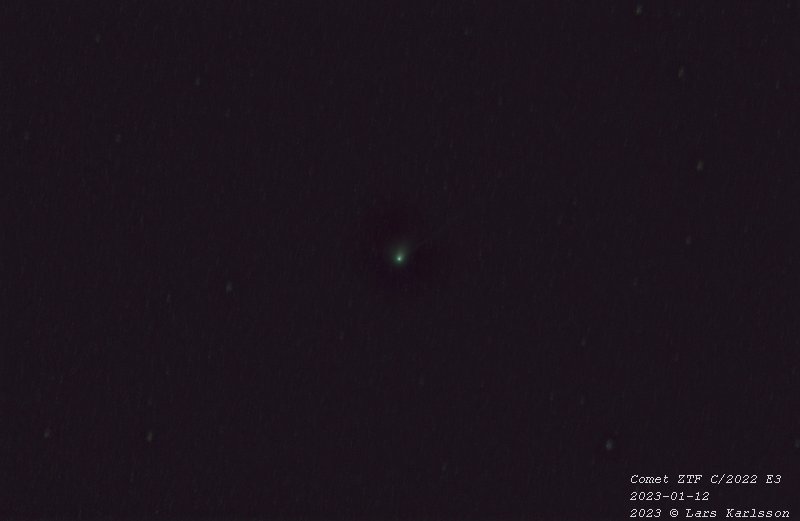
|
| Date : | 2023-01-12 |
| Time (UT) : | 02:23 to 03:58 |
| Mount : | SkyWatcher EQ6 Pro, Belt drive, beltdrive modified (DIY 2019) |
| Guide : | QHY5 camera with 200 mm f/3.5 lens |
| Lens/telescope : | Pentax 645 300 mm ED f/4 (medium format lens) |
| Corrector/Barlow : | - |
| Field (FOV) : | 6.8x4.5o (full frame) before crop |
| camera : | Canon 6D, QE=0.5, full frame, 20 Mpixel, 14 bit |
| camera temperature: | About 6o C above surrounding temperature |
| Film/CCD : | Raw, Cr2 |
| Filter : | none |
| Control system: | Mount, camera, focus, guide (Ekos) controlled by Astroberry (KStars/Ekos Linux) |
| Exp. time : | 49x60 second at iso1600 |
| Image process tool : | Siril, Gimp, Irfanview |
| Processing : | cal dark, flat align on comet core |
| Weather : | In the beginning clouds, last 45 minutes a clear sky |
| Site : | Sweden, Stockholm, Hagsätra.
Bortle 9 Free view Az: 20o to 90o, 165o to 185o, Alt: 20o to 55o |
| Comment : | The weather forecast didn't say anything about a clear sky this night. After midnight I setup the equipment and got this. The comet is brighter now and easier to find, magnitude 6.8. At December 24 it had a magnitude of 8.2, so it has increased 1.4 magnitudes in 19 nights. It will increase at least 1.5 magnitude more at the end of January. |
A zoom in around the comet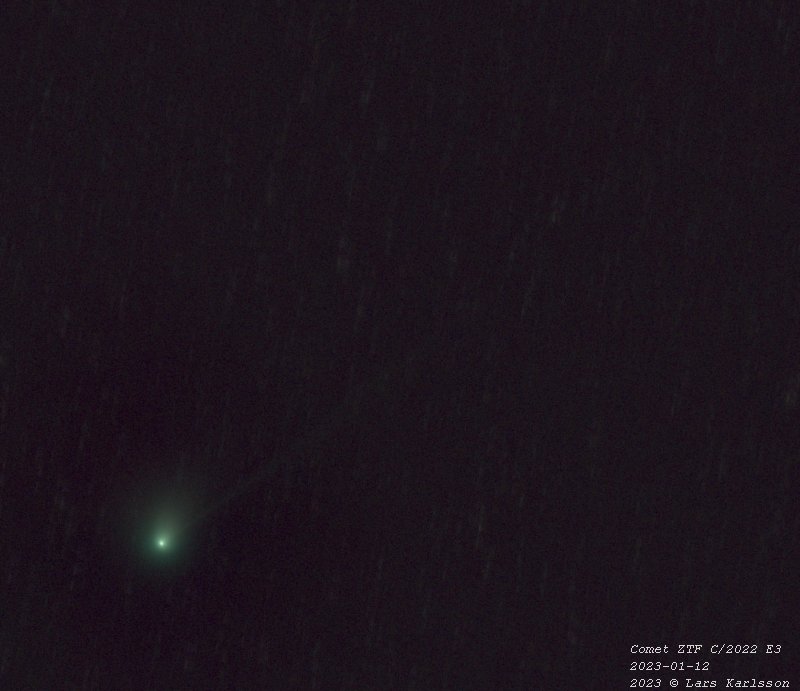
|
| Date : | 2023-01-12 |
| Time (UT) : | 02:23 to 03:58 |
| Processing : | A zoom in around the comet |
| Comment : | This was a surprise, now the tail is much stronger and you can follow it a long way out from the comet core. If I had been at a dark place this had looked gorgeous. |
2023-01-04, Third clear night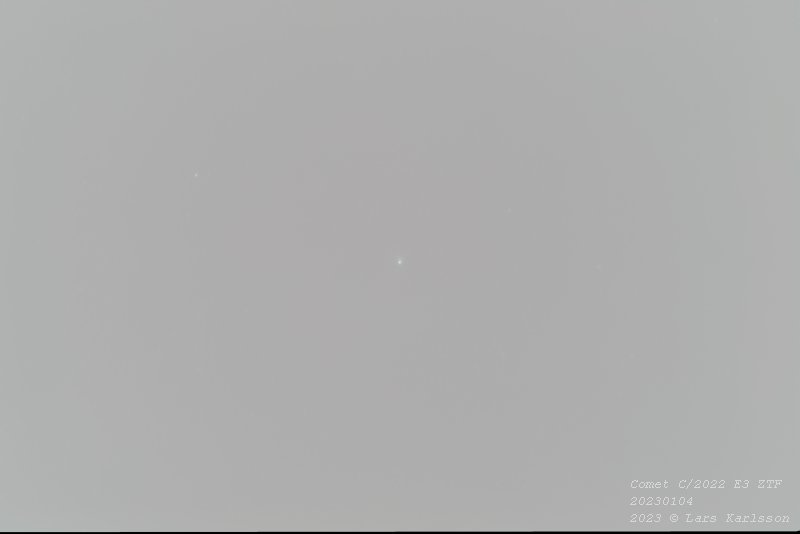
A hopeless case or, before processing the image 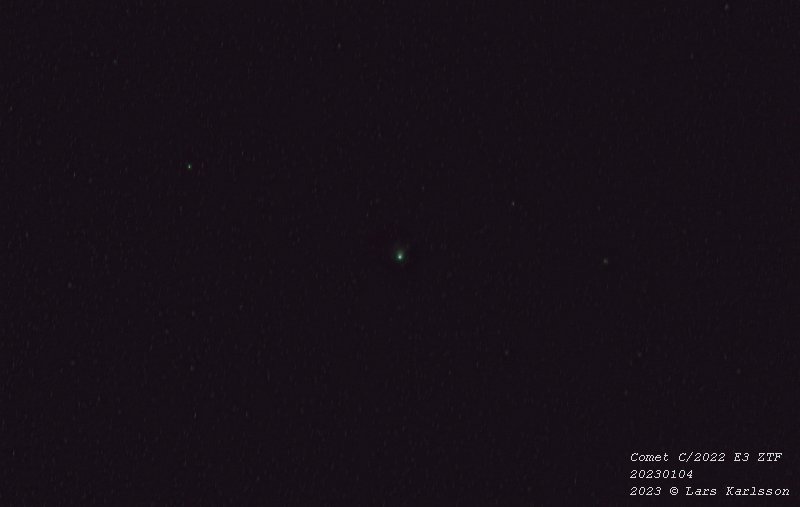
|
| Date : | 2023-01-04 |
| Time (UT) : | 01:47 to 03:44 |
| Mount : | SkyWatcher HEQ5, belt modified, low rider |
| Guide : | QHY5 camera with 200 mm f/3.5 lens |
| Lens/telescope : | Pentax 645 300 mm ED f/4 (medium format lens) |
| Corrector/Barlow : | - |
| Field (FOV) : | 6.8x4.5o (full frame) before crop |
| camera : | Canon 6D, QE=0.5, full frame, 20 Mpixel, 14 bit |
| camera temperature: | About 6o C above surrounding temperature |
| Film/CCD : | Raw, Cr2 |
| Filter : | none |
| Control system: | Mount, camera, focus, guide (Ekos) controlled by Astroberry (KStars/Ekos Linux) |
| Exp. time : | 90x60 second at iso1600 |
| Image process tool : | Siril, Gimp, Irfanview |
| Processing : | cal dark, flat align on comet core |
| Weather : | clear sky |
| Site : | Sweden, Stockholm, Hagsätra.
Bortle 9 Free view Az: 20o to 90o, 165o to 185o, Alt: 20o to 55o |
| Comment : | One more night with a clear sky, but it wasn't as dark as earlier nights. To compensate for that I took much more photos to lower the noise, in total 1.5 hours exposure. |
A crop around the comet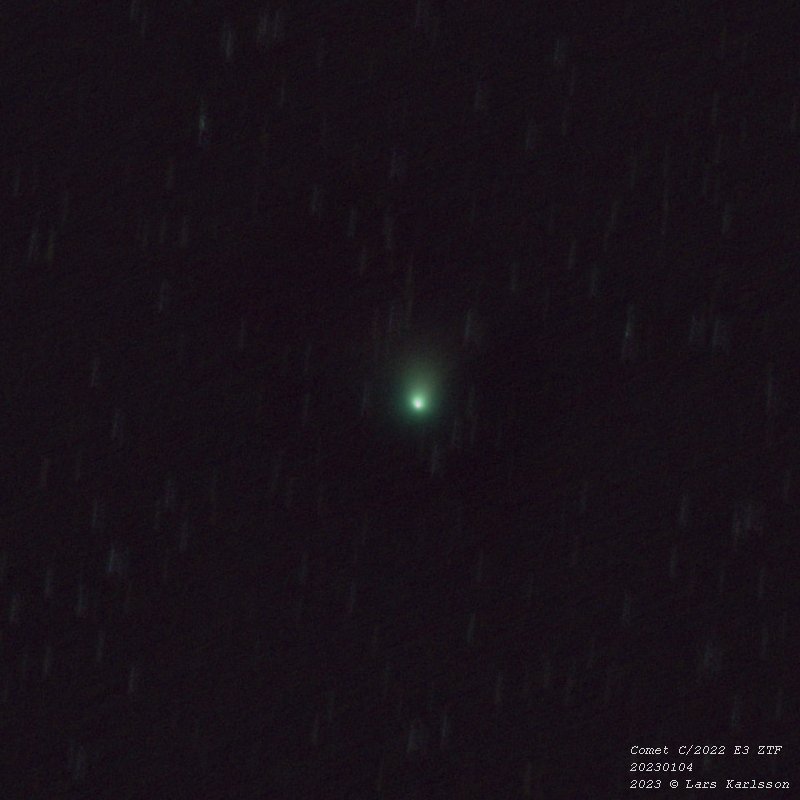
|
| Date : | 2023-01-04 |
| Time (UT) : | 01:47 to 03:44 |
| Processing : | A 800x800 1:1 pixel crop around the comet |
| Comment : | The last photo was taken early in the morning at 4:44. Never taken a astrophoto that late before. Four weeks later and the comet is at it's closest distance to Earth and I hope to get some nice photos of its tale then. This night the magnitude of the comet has reach 7.4. Two magnitudes brighter than the PanSTARRS comet I photographed the same night. |
2022-12-28, Second clear night
|
| Date : | 2022-12-28 |
| Time (UT) : | 02:27 to 03:04 |
| Mount : | SkyWatcher HEQ5, belt modified, low rider |
| Guide : | QHY5 camera with 200 mm f/3.5 lens |
| Lens/telescope : | Pentax 645 300 mm ED f/4 (medium format lens) |
| Corrector/Barlow : | - |
| Field (FOV) : | 6.8x4.5o (full frame) before crop |
| camera : | Canon 6D, QE=0.5, full frame, 20 Mpixel, 14 bit |
| camera temperature: | About 6o C above surrounding temperature |
| Film/CCD : | Raw, Cr2 |
| Filter : | none |
| Control system: | Mount, camera, focus, guide (Ekos) controlled by Astroberry (KStars/Ekos Linux) |
| Exp. time : | 30x60 second at iso1600 |
| Image process tool : | Siril, Fitswork, Irfanview |
| Processing : | crop, resize, level, cal dark, bias, flat align on comet core |
| Weather : | clear sky |
| Site : | Sweden, Stockholm, Hagsätra.
Bortle 9 Free view Az: 20o to 90o, 165o to 185o, Alt: 20o to 55o |
| Comment : | Four days later I could take more photos of the comet, still very distant and weak. Compare the two photos and see how the tail has developed, not any big difference. The exposure time is increased from 30 seconds to 60 second. I can do that when the comet is far away and doesn't move much during the exposure. It has now magnitude 7.9. |
A crop around the comet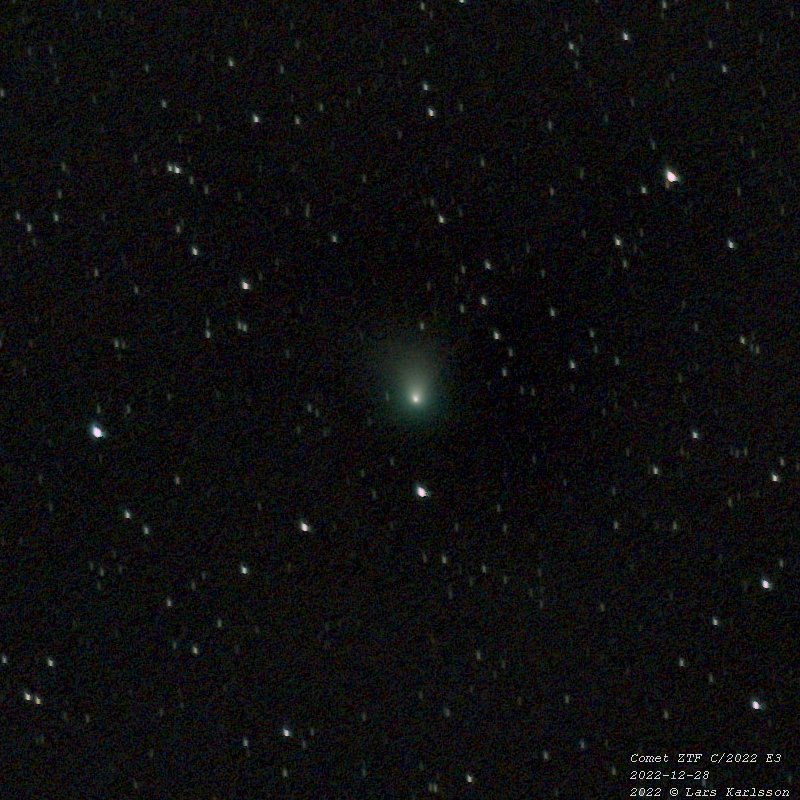
|
| Date : | 2022-12-28 |
| Time (UT) : | 02:27 to 03:04 |
| Processing : | A 800x800 1:1 pixel crop around the comet |
| Comment : | The total exposure time is 30 minutes this time compared to 46 minutes I took before. The dust tail can be seen pointing upwards. |
2022-12-24, First night with a clear sky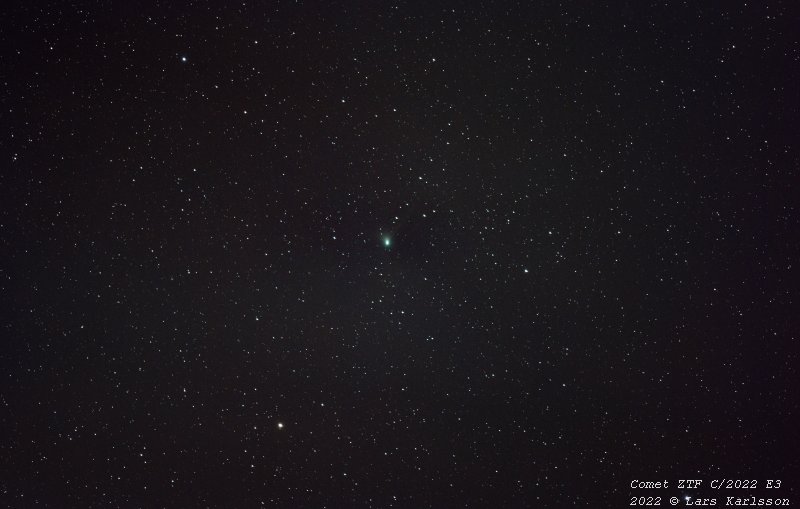
|
| Date : | 2022-12-24 |
| Time (UT) : | 02:45 to 04:18 |
| Mount : | SkyWatcher HEQ5, belt modified, low rider |
| Guide : | QHY5 camera with 200 mm f/3.5 lens |
| Lens/telescope : | Pentax 645 300 mm ED f/4 (medium format lens) |
| Corrector/Barlow : | - |
| Field (FOV) : | 6.8x4.5o (full frame) before crop |
| camera : | Canon 6D, QE=0.5, full frame, 20 Mpixel, 14 bit |
| camera temperature: | About 6o C above surrounding temperature |
| Film/CCD : | Raw, Cr2 |
| Filter : | none |
| Control system: | Mount, camera, focus, guide (Ekos) controlled by Astroberry (KStars/Ekos Linux) |
| Exp. time : | 185x15 second at iso1600 |
| Image process tool : | Siril, Fitswork, Irfanview |
| Processing : | crop, resize, level, cal dark, bias, flat align on comet core |
| Weather : | clear sky |
| Site : | Sweden, Stockholm, Hagsätra.
Bortle 9 Free view Az: 20o to 90o, 165o to 185o, Alt: 20o to 55o |
| Comment : |
I have waited a couple of weeks for a clear sky to take a photo of this comet.
Comets are always exiting and I don't want to miss the opportunity to take a photo of a new comet.
The sky from our balcony is heavily light polluted and the comet must be bright enough to overcome that.
It has now the magnitude 8.2. The balcony rail blocked the view for the guide camera so couldn't use it. I couldn't get the Siril lock on the comet either when aligning, but no big problem because the comet is so far away these days and don't move much, about 30" / hour. The distance to the comet is 1.37 AU, Astronomical Unit. The estimated length of the tail is 0.05 AU, that is 1/20 of the distance to the Sun. That is really long, it will take the light from the core of the comet almost a half minute to travel to the end of the tail. The view is about 4x6 degrees after I cropped it a bit. |
A crop around the comet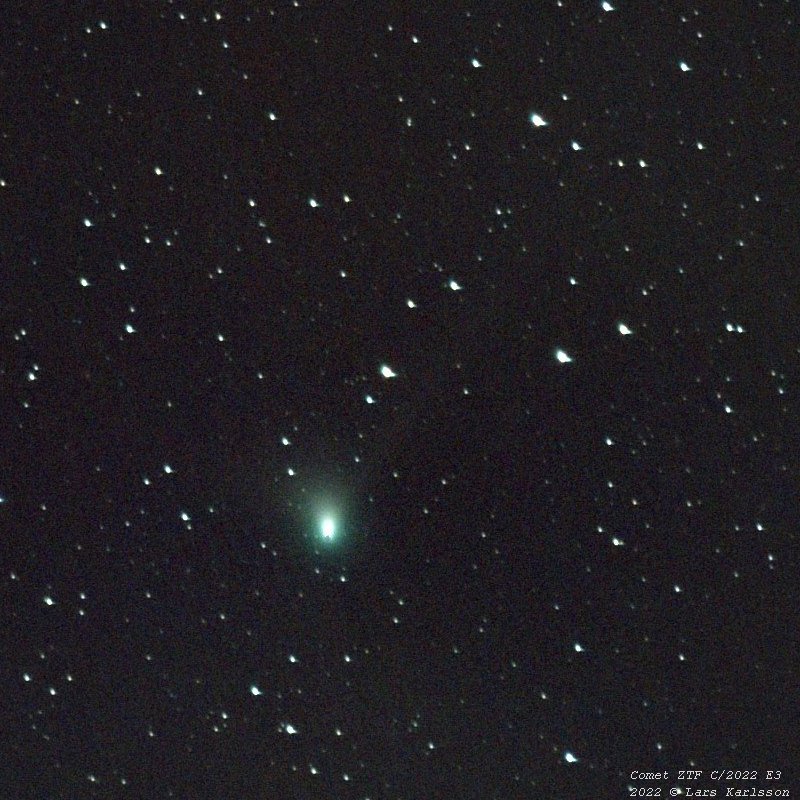
|
| Date : | 2022-12-24 |
| Time (UT) : | 02:45 to 04:18 |
| Processing : | A 800x800 1:1 pixel crop around the comet |
| Comment : | The tail can be seen as a weak line towards 1 o'clock. The comet is expected to have its peak in brightness in February 2nd when it reach about magnitude 5. Now in December it rise in Northeast which I have an open view to from our balcony. When I took the photo it was about 29 degrees above the horizon early in the morning. |
|
Other sources of information:
|
|
| Go Back |